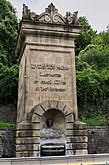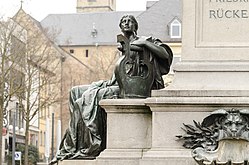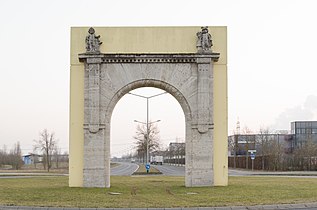Monuments and fountains in Schweinfurt
The article Monuments and Fountains in Schweinfurt gives an overview of the monuments, industrial monuments, fountains and memorials in Schweinfurt .
Monuments and fountains
Ludwigsbrunnen
The Ludwigsbrunnen (1830, classicism ) by Johann Nepomuk Pertsch stands at the foot of the historic vineyards on the old Mainleitenstrasse, which was first mentioned in 1407, today's Mainbergerstrasse. From 1826 to 1829 the city of Schweinfurt had the street expanded and paved. On this occasion, this fountain was built in honor of the Bavarian King Ludwig I. According to tradition, Ludwig I with his carriage got stuck in the mud on Mainleitenstrasse and then prompted the road to be expanded.
Rückert monument
The Rückert monument (1890) on the market square is a bronze cast by Wilhelm von Rümann and Friedrich von Thiersch for the poet and pioneering translator of oriental poetry Friedrich Rückert , who was born in Schweinfurt in 1788 and who spoke at least 44 languages. At the feet of the poet sitting on a chair are allegorical figures from his work The Armored Sonnets , which he wrote in 1813 under the pseudonym Freimund Raimar against Napoleon I and the wisdom of the Brahmin .
Plaque at the birthplace of
Friedrich Rückert
War memorial at the old cemetery
At the old cemetery, opposite the Heilig-Geist-Kirche , there are two lions at the entrance portal, remains of the war memorial by Ignatius Taschner (1895) for the fallen of the Franco-German War 1870/71, which was melted down in World War II .
Rossbändiger fountain
The Rossbändiger fountain (1934, neoclassicism ) by Josef Wackerle is on the square in front of the art gallery .
Monument at the Willy Sachs Stadium
The monument at the Willy Sachs Stadium (1936, neoclassicism) is a bronze cast by Ludwig Gies in honor of the stadium founder Willy Sachs . On a pylon rests a National Socialist imperial eagle von Gies, which also created the federal eagle in the plenary hall of Bonn's federal building . This memorial is known nationwide and has been depicted repeatedly in the media due to the stadium name and the links between Willy Sachs and National Socialism and the presence of Heinrich Himmler and Hermann Göring at the inauguration of the stadium.
Fountain in Châteaudun Park
A fountain by Torolf Engström (1966) is located in the Châteaudun Park on a lawn in front of the city theater that is used as a sunbathing area in summer . It is illuminated at night, consists of two shells made of concrete and steel and is a listed building.
anchor
The anchor by the Berlin artist couple Brigitte and Martin Matschinsky-Denninghoff is a monomental sculpture on the eastern end of the lock island. Brigitte Matschinsky-Denninghoff was assistant to Henry Moore .
Rossbändiger-Brunnen (1934)
at the Kunsthalle SchweinfurtMonument at the Willy Sachs Stadium
(1936)Olympia Fulvia Morata
in BrückenstraßeAnchor
on the lock islandFountain
in the Stadtgalerie Schweinfurt
(2009)
Industrial monuments
Grab crane
A rotary grab crane from the company Noell from Würzburg from 1926 is an industrial monument at the confluence of the Marienbach into the Main. The crane was in use at the same location at the then Blum sand dredging plant until the 1970s. There on the banks of the Main, near the Zollhof, had been the designated route for street prostitution, which was closed in 2009 because of the consideration for tourists at the pier for cruise ships .
Old port crane
Another crane memorial from 1852 on Ziehweg, the former path on Gutermann-Promenade, comes from the small machine factory JW Spaeth from Nuremberg , which in 1835 supplied the individual parts for the Adler locomotive of the first German ones from Newcastle by Robert Stephenson and Company Assembled railroad.
Roller weir monument
The roller weir memorial (1903/1965) is a chain hoist device for the world's first roller weir from MAN (1903). The technology was developed by Max Carstanjen for the Schweinfurt weir, which, as a bottom outlet, regulated the water level on the main arm of the Main at the Maxbrücke until it was expanded into a federal waterway in 1962. The elevator device was erected in 1965 as a technical monument on Gutermannpromenade. The prototype from 1902 of this roller weir is still in operation on a small tributary of the Main between the Maininsel Bleichrasen and the Böckleinsinsel .
SKF Art Nouveau doors
When plant 1 of the Swedish ball bearing factory SKF in Schrammstraße was demolished at the turn of the millennium, two Art Nouveau doors (around 1908) were removed. One was rebuilt in 2009 close to the original location, in Sattlerstraße, at the newly built city gallery in Schweinfurt . The second gate had been set up a few years earlier in Europa-Allee, in the middle of the first roundabout at the entrance to the Maintal industrial and commercial park .
Great Beijing Wheel warehouse duplicate
A duplicate of the Great Beijing Wheel camp (2012) is also in Châteaudun Park in front of the City Theater . After FAG Kugelfischer had developed and built the two spherical roller bearings for the London Eye in Schweinfurt , it was commissioned to develop the bearings for the largest, 208 m high Ferris wheel in the world in Chaoyang Park in Beijing . The construction work began in 2006, the planned completion date for the 2008 Olympic Games was not met and in 2010 the work was stopped because the responsible company filed for bankruptcy. Then a duplicate of the two Beijing camps, each weighing 10 tons and with an outer diameter of 3.20 m, was set up at the city theater. The inside diameter of the bearing is exactly the same as the outside diameter of the London Eye bearing .
SKF youth style door
(approx. 1908 / approx. 2007)Duplicate of the Great Beijing Wheel Camp (2012)
at the City Theater
Memorials
Memorial for the victims of forced labor
The memorial for the victims of forced labor (2011) by Herman de Vries is a 3 km long camp path and memorial with three linden trees on the Main in Oberndorf . The path leads along the former Kugelfischer forced labor camp as a memorial for the more than 10,000 forced laborers who were also recruited from prisoners of war and had to work in the Schweinfurt armaments industry. Many slave laborers were killed in bomb attacks because they were not allowed to seek protection in the city's bunkers . The Dutch artist pointed out that the first sentence of the German constitution , “Human dignity is inviolable”, which he chiseled into a stone, is not in any other country's constitution - “a wonderful constitution, thanks to experience of history. ”There was public criticism that there was no such monument in the city for a long time and that a private initiative had to fill this gap.
See also: Schweinfurt industrial history, World War II
Memorial stone for the victims of flight, displacement and forced labor
A memorial stone for the victims of flight, displacement and forced labor (2014) by Steff Baur is located in the old cemetery . The left part of the stone has the lower inner shape of the letter "N" for "nemec" , which means German in the Slavic languages . The “N” was the symbol that Germans had to wear on a piece of cloth or armband in the expulsion areas , analogous to the “KG” of the prisoners of war or “OST” of the Eastern workers in the National Socialist territory. On a bronze plaque on the right stone there are words of thanks to the city of Schweinfurt for accepting 32,000 refugees, displaced persons and repatriates .
See also: Schweinfurt industrial history, World War II
German-American Air War Memorial
In 1998 the German-American aerial war memorial was erected in front of the bunker on Spitalseeplatz . The memorial created by the Schweinfurt artist G. Hubert Neidhart is the first and only one of its kind in Germany. It was designed and financed jointly by the former war opponents. It is particularly reminiscent of “Black Thursday”, October 14, 1943, when the Americans suffered their greatest defeat in the air over Schweinfurt. 600 people lost their lives from the bomber crews.
The former enemies in World War II , the bomber crews and the German high school students deployed as air force helpers in the anti-aircraft positions in and around Schweinfurt became friends. For it bears on the US side, the S econd S chweinfurt M emorial A. ssociation (SSMA) concern the reference 1943 already takes on their behalf to the second raid on Schweinfurt on 14 October. Around 100 pilots and crew members who survived this air battle founded the Veterans Association in America in the mid-1970s.
In 1993 the SSMA first contacted the former air force helpers in Schweinfurt. At the first meeting that followed, the idea finally matured to erect the joint memorial as the first outside the USA . The high point of social life are the annual meetings ( reunions ) of the SSMA on October 14th in the USA and in Schweinfurt.
As the text on the steel plate says, the air war memorial is expressly dedicated to the victims from both nations and also to the civilian victims of the entire air war.
In 2019, 95-year-old Roland Martin from California visited the memorial. A few days before his 20th birthday, became the youngest pilot in the US Air Force with a Boeing B-17 bombers, the so-called Flying Fortress shot down (Flying Fortress) over Schweinfurt.
See also: History of Schweinfurt, Second World War (Third City Disaster)
See also
literature
- Erich Schneider: Schweinfurt and its monuments - architecture-art-technology . Verlagshaus Weppert, Schweinfurt 2015, ISBN 978-3-9803695-9-6 .
Individual evidence
- ^ Peter Hofmann: Schweinfurt Guide. My Schweinfurt; Ludwigsbrunnen. Retrieved February 7, 2016 .
- ↑ TV-Touring Schweinfurt, January 30, 2016.
- ↑ Bertelsmann Universal Lexicon. Gütersloh 1989.
- ↑ swity.de: Red light and prostitution in Schweinfurt. Retrieved January 19, 2017 .
- ↑ Schweinfurt city culture topics. Publication of the Schweinfurter Tagblatt for the Handelsblatt and Die Zeit. May 20, 2009.
- ↑ Culture Office of the City of Schweinfurt: River and Diligence. Vier-Türme GmbH, Benedict Press, Münsterschwarzach Abbey
- ↑ In and around Schweinfurt.de: The floating large warehouse. September 6, 2012.
- ↑ Ökopax.de: Three linden trees against forgetting - forced labor in Schweinfurt. Retrieved February 7, 2016 .
- ^ Initiative against forgetting. Forced labor in Schweinfurt. Memorial in Oberndorf. (No longer available online.) Archived from the original on April 16, 2016 ; accessed on February 7, 2016 .
- ↑ Memorial dedicated to the victims of flight, displacement and forced labor in Schweinfurt. (No longer available online.) Archived from the original on February 7, 2016 ; accessed on February 7, 2016 .
- ↑ a b c d mainpost.de: Signs of Reconciliation, October 13, 2008. Retrieved February 22, 2019 .
- ↑ mainpost.de: Shot down over Schweinfurt 76 years ago: US pilot returns, September 18, 2019. Retrieved November 30, 2019 .



















